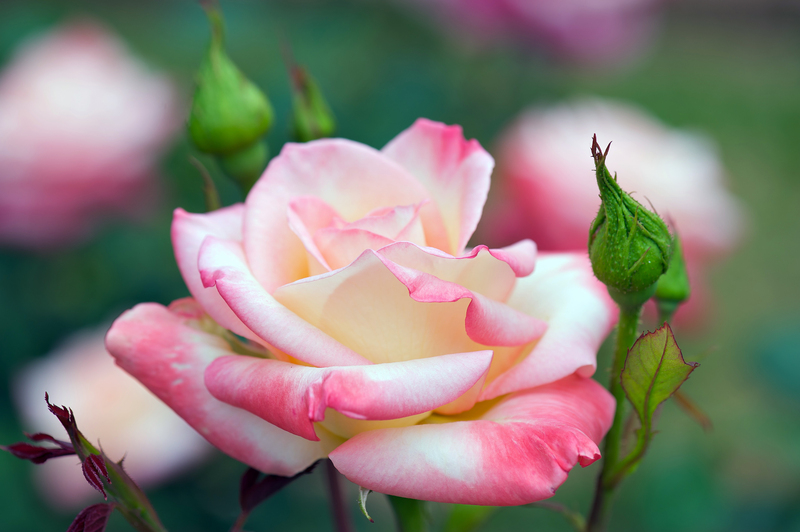Ingenious Winter Plant Protection Techniques for You
Posted on 11/09/2025
Ingenious Winter Plant Protection Techniques for You
Winter can be a challenging season for gardeners and plant enthusiasts. Dropping temperatures, frosty nights, and biting winds all pose a significant risk to the health and vitality of your precious plants. Luckily, there are numerous innovative winter plant protection techniques that can help keep your garden thriving throughout the coldest months. In this comprehensive guide, we'll explore a variety of ingenious strategies for safeguarding your garden and indoor plants during winter. Whether you're an experienced horticulturist or a beginner with a budding green thumb, you'll discover actionable tips to ensure year-round plant health.

Understanding the Risks of Winter on Plants
Before diving into clever winter plant protection methods, it's crucial to understand the dangers that winter weather poses:
- Freezing Temperatures: These can damage plant cells, resulting in wilted leaves, blackened stems, or outright plant death.
- Frost and Ice: Frost can form on plant surfaces, damaging delicate tissues. Ice buildup can break branches or suffocate roots.
- Dehydration: Paradoxically, many plants dehydrate during winter because their water source freezes.
- Wind Burn: Strong winter winds strip moisture from leaves and cause desiccation.
- Sunning: The sun reflecting off snow can scorch plant tissues, especially evergreens.
Armed with knowledge about these challenges, let's dive into practical, ingenious winter protection techniques for your plants.
1. Mulching: Nature's Blanket for Plants
One of the simplest and most effective ways to protect plants during winter is by applying mulch. This natural insulator keeps the ground temperature stable, prevents sudden temperature swings, and conserves soil moisture.
Choosing the Right Mulch
- Organic Mulches: Straw, wood chips, shredded leaves, or pine needles are excellent options. They decompose over time, enriching the soil.
- Inorganic Mulches: Gravel or rubber mulch works best for paths but can also be used strategically to prevent frost heaving.
How to Mulch Effectively
- Apply a layer of mulch 2-4 inches thick around the root zone, avoiding direct contact with the stems or trunks.
- Refresh and fluff up the mulch regularly to maintain its insulative properties.
- Remove excess mulch in spring to prevent rot and pest infestations.
2. Cloches and Plant Covers: Miniature Greenhouses
Cloches and plant covers are ingenious inventions that act as tiny greenhouses for individual plants. They dramatically minimize frost damage and conserve warmth.
Types of Plant Covers
- Glass or Plastic Cloches: Traditionally bell-shaped, these covers trap heat and humidity around delicate plants.
- Frost Blankets: Light, breathable fabric covers can be thrown over beds during cold snaps (floating row covers are especially effective).
- DIY Solutions: Use upturned plastic bottles, milk jugs with the bottoms removed, even buckets or cardboard boxes in a pinch.
Tips for Using Plant Covers
- Ensure covers touch the ground and are weighed down to prevent cold air from entering.
- Remove covers during sunny days to avoid overheating.
- Use ventilated cloches or poke holes to allow some airflow.
3. Windbreaks: Safeguarding Plants from Desiccating Winds
Even if your region doesn't experience extreme cold, winter winds can cause severe damage. Setting up windbreaks is an innovative winter plant protection strategy that shields vulnerable plants from the drying effects of winter gales.
How to Create Effective Windbreaks
- Natural Barriers: Evergreen hedges, dense shrubbery, or clusters of trees planted strategically can serve as wind barriers.
- Artificial Windbreaks: Burlap screens attached to stakes, wooden fencing, or even snow fences can break the force of the wind.
- Temporary Solutions: Position large plywood panels, old doors, or rolled-up garden mats around sensitive beds for short-term protection.
Placement and Maintenance Tips
- Install windbreaks perpendicular to prevailing seasonal winds.
- Keep them a few feet away from the plants to allow for air circulation and prevent mildew.
- Check and reinforce structures after storms or heavy snow.
4. Protecting Containers and Potted Plants
Container plants and pots are particularly vulnerable in winter. Their limited soil volume gets colder and dries out faster. Here's how to provide ingenious winter plant protection for them:
- Group pots together in a sheltered spot, ideally close to a building wall for added warmth.
- Elevate containers off the ground with pot feet or bricks to prevent freezing from below.
- Wrap pots with bubble wrap, burlap, or horticultural fleece, securing with twine or tape.
- Consider double-potting: place the original pot inside a larger container and fill the gap with straw or leaves for insulation.
- Water moderately--dry soil freezes more quickly, but overwatering risks root rot.
- Move especially delicate plants indoors or into a greenhouse if possible.
5. Watering Wisely: Hydration is Key
It's a myth that plants don't need water in winter. In fact, winter dehydration is a leading cause of plant stress. Here's how to water plants in winter to improve their survival odds:
- Water early in the day when temperatures are above freezing, allowing moisture to soak in before nightly temperature drops.
- Focus on the root zone rather than wetting foliage (to prevent ice formation).
- Use lukewarm water to avoid shocking fragile roots.
- For evergreens, deep, occasional waterings are more effective than frequent light applications.
- Monitor pots and raised beds, as they dry out faster than in-ground beds.
6. Smart Use of Greenhouses and Cold Frames
If you have the space and resources, investing in a greenhouse or constructing a simple cold frame can extend your growing season and ensure optimal winter plant protection.
The Benefits of Greenhouses
- Stable, controlled temperature and humidity environments for sensitive or tropical plants.
- Protection from wind, frost, pests, and heavy snowfall.
- Ability to force bulbs or start seedlings early in the season.
DIY Cold Frames
- Build a frame from wood and cover with old windows or polycarbonate sheets.
- Place over garden beds to trap heat and protect newly planted vegetables or perennials.
- Lift the lid or open edges for ventilation during sunny days.
7. Pruning and Plant Care Before Winter
Good plant protection starts before winter arrives. Proper pruning and maintenance in autumn can help your plants face the cold:
- Remove dead or diseased branches to prevent breakage under snow and ice.
- Prune only as recommended--some plants, like hydrangeas, set buds on old wood and should not be cut back in fall.
- Stop fertilizing perennials a month before the first frost so they don't produce tender new growth that can't survive winter.
- Tidy beds of old foliage and debris to eliminate overwintering sites for pests and diseases.
8. Using Anti-Desiccant Sprays for Evergreens
Evergreen shrubs and trees lose water through their leaves all winter, even when the ground is frozen. Anti-desiccant sprays (or anti-transpirants) are ingenious products that create a thin, waxy barrier on foliage:
- Apply on a calm, dry day, when temperatures are above freezing.
- Focus on broadleaf evergreens like rhododendrons, hollies, or boxwoods.
- Repeat applications every few weeks or after heavy rains as needed.
9. Harnessing Technology: Smart Sensors and Heating
With modern technology, you can protect your garden in winter even more efficiently. Here are some 21st-century tools to help:
- Soil Temperature Sensors: Bluetooth or WiFi-enabled sensors send alerts when your soil gets dangerously cold, prompting you to take action.
- Soil Heaters and Heating Cables: For prized specimens, install soil heating mats or underground cables to gently warm the root zone.
- Frost Alarms: These handy devices warn you of freezing conditions so you can quickly cover vulnerable plants.
- Smart Irrigation Timers: Program watering to coincide with mild spells during the winter months.
10. Native Plants: The Ultimate Winter Survivors
While all these winter garden protection techniques are invaluable, the most ingenious method is often choosing plants that are naturally hardy to your region. Native species have evolved to withstand your local winters, making them lower maintenance and more reliable.
Benefits of Native Plants
- Require fewer resources and less intervention to survive harsh winters.
- Provide food and shelter for local wildlife even when other food sources are scarce.
- Less likely to suffer from disease and pest attacks.

Frequently Asked Questions About Winter Plant Protection
What Should I Cover My Plants With During a Freeze?
Use fabric materials like frost blankets, burlap, old sheets, or specialized garden fleece. Avoid plastic sheeting for extended periods, as it can cause overheating or trap moisture, leading to rot.
When Should I Mulch My Garden for Winter?
Once the ground has frozen in late fall, apply mulch to help insulate soil and protect roots. This timing prevents rodents from setting up home beneath your mulch.
Can I Use Christmas Lights for Winter Plant Protection?
Yes! Old-style (non-LED) incandescent lights generate a small amount of heat, which can help prevent frost damage on trees and shrubs. Wrap them loosely and avoid lights that get too hot or could become a fire hazard.
How Do I Protect Young Trees from Winter Damage?
Wrap trunks with tree wrap or use spiral guards to prevent sunscald and damage from gnawing animals. Apply mulch around the base, and shield from wind with burlap screens if needed.
Conclusion: Embrace Ingenious Winter Plant Protection
With a blend of creativity, preparation, and technology, you can shield your plants through winter's harshest conditions. From mulching, cloches, and windbreaks to cutting-edge sensors and native plant choices, this season doesn't have to spell doom for your beloved garden. By applying these tried-and-true and innovative winter plant protection techniques, you'll enjoy a garden that emerges from the cold months healthier and more beautiful than ever before. Happy gardening through winter and beyond!



